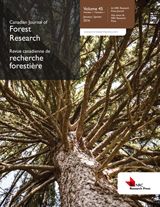Smith et al., 2017
Variability in aboveground carbon dynamics driven by slope aspect and curvature in an eastern deciduous forest, USA
Smith, L., Eissenstat, D., and Kaye, M. (2017)
Canadian Journal of Forest Research, vol. 47: 149–158
-
Shale Hills, GRAD STUDENT
-
Shale Hills, INVESTIGATOR
-
Shale Hills, INVESTIGATOR
Abstract
In forested ecosystems, topography and tree species contribute to spatial variability in carbon (C) dynamics through differential rates of C uptake and storage; therefore, estimates of species-specific and spatial variability in C can strengthen ecosystem budgets. To produce such estimates, we deconstructed watershed-scale C and component pools (e.g., wood biomass, litter) and fluxes at a fine scale using a small mixed deciduous forest catchment to determine the variation due to topographic position and species. Factors affecting fluxes included aspect, slope curvature, tree species contributions, and litter production. Annual C uptake into wood varied across the catchment from 0 to 34 kg C·year−1 and was 20% greater on southern aspects than northern ones and 33% greater in swales than non-swale slopes. Of the more than 20 tree species found in the forest canopy of the catchment, highest C uptake in woody biomass was measured in Quercus rubra L. growing in swales, followed by Quercus prinus L. syn. growing on the southern aspect, with the lowest aboveground wood increment measured in Pinus at higher elevations on non-swale slopes. Quercus leaf litter moved from where it dropped into litter traps to where it settled on the forest floor, shifting the location of litter C inputs to the soil. Local variation in aboveground C rivals regional variation across regions and has the potential to introduce error when scaling C measures from points to landscapes.
Citation
Smith, L., Eissenstat, D., and Kaye, M. (2017): Variability in aboveground carbon dynamics driven by slope aspect and curvature in an eastern deciduous forest, USA. Canadian Journal of Forest Research, vol. 47: 149–158. DOI: 10.1139/cjfr-2016-0147
 This Paper/Book acknowledges NSF CZO grant support.
This Paper/Book acknowledges NSF CZO grant support.
Explore Further




